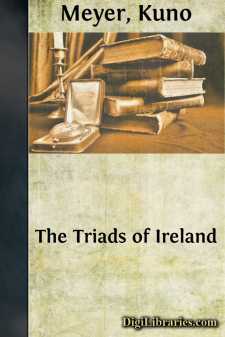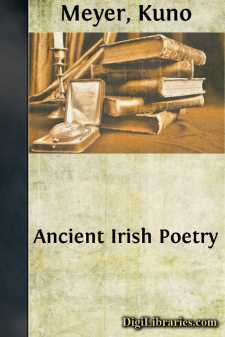Categories
- Antiques & Collectibles 13
- Architecture 36
- Art 48
- Bibles 22
- Biography & Autobiography 813
- Body, Mind & Spirit 141
- Business & Economics 28
- Children's Books 12
- Children's Fiction 9
- Computers 4
- Cooking 94
- Crafts & Hobbies 4
- Drama 346
- Education 46
- Family & Relationships 57
- Fiction 11826
- Games 19
- Gardening 17
- Health & Fitness 34
- History 1377
- House & Home 1
- Humor 147
- Juvenile Fiction 1873
- Juvenile Nonfiction 202
- Language Arts & Disciplines 88
- Law 16
- Literary Collections 686
- Literary Criticism 179
- Mathematics 13
- Medical 41
- Music 40
- Nature 179
- Non-Classifiable 1768
- Performing Arts 7
- Periodicals 1453
- Philosophy 64
- Photography 2
- Poetry 896
- Political Science 203
- Psychology 42
- Reference 154
- Religion 513
- Science 126
- Self-Help 83
- Social Science 81
- Sports & Recreation 34
- Study Aids 3
- Technology & Engineering 59
- Transportation 23
- Travel 463
- True Crime 29
The Triads of Ireland
by: Kuno Meyer
Description:
Excerpt
PREFACE
The collection of Irish Triads, which is here edited and translated for the first time, has come down to us in the following nine manuscripts, dating from the fourteenth to the nineteenth century:—
L, i.e. the Yellow Book of Lecan, a vellum of the end of the fourteenth century, pp. 414b—418a, a complete copy.
B, i.e. the Book of Ballymote, a vellum of the end of the fourteenth century, pp. 65b-66b (ends imperfectly).
M, i.e. the Book of Húi Maine, a vellum of the fourteenth century, fo. 190a[1]-fo. 191a[2]. A complete copy beginning: 'Ceand Erenn Ardmacha,' and ending: 'tri hurgairt bidh a caitheam dÃescaidheadh (sic) a chaitheam iarna coir a caitheam gan altughudh.' Then follow proverbial sayings from the 'colloquy of Cormac and Cairpre,' such as: 'Dedhe ara ndligh gach maith domelar ithe âÂÅ altugud. Anas deach gacha fleidhe a cainaltughudh âÂÅ a mochdingbail. Caidhe deach samtha. Ni hansa. Gal gan forran. Deasgaidh codulta frislige,' &c., ending: 'deasgaidh aineolais imreasain. Ni d'agallaim Cormaic âÂÅ Cairpre coruici sin.'
Lec, i.e. the Book of Lecan, a vellum of the fifteenth century. The leaves on which the Triads are found are now bound up with the codex H. 2. 17 belonging to Trinity College. It is a complete copy beginning on p. 183b: 'Ceand erenn Ardmacha,' and ending on p. 184b: 'ceitheora aipgitri baisi baig connailbi gell imreasain.' N, i.e. 23. N. 10, a paper ms. written in the year 1575, pp. 98-101. A complete copy, the gap between pp. 100 and 106 being made up by pp. 7a-10b of the vellum portion of the manuscript.
By an oversight I have referred to this ms. sometimes by Lec and sometimes by H. In some cases both Lec and H will be found quoted in the variants. The same ms. is always meant.
As appears from the following colophon on p. 101: 'Oraoit uaim ar do lebor a hOedh in cédluan iar n-aurtach Johannes. Baile Tibhaird ar bla maige mo mendad scribne hi farrad Se(a)ain hi Maoilconari. Mese (Dubthach) do scrib in ball soin da derpiris âÂÅ rlæ. Anno domini 1575. Guroiuh maith agat.
Hù, i.e. H. 1. 15, pp. 946-957. This is a paper manuscript written by Tadhg Tiorthach O Neachtain in 1745. It is a complete copy, with copious glosses in Modern Irish, the more important of which are printed below on pp. 36-43. At the end O Neachtain has added the following:—'Trà subhailce diadha: creidhemh, dothchus agus grádh. Trà a n-aon: athair, mac, spiorad naomh, da raibh gloir, mola[dh] âÂÅ umhlacht tre bith sior tug ré don bhochtan bocht so. Aniu an 15 do bhealltuine 1745. Tadhg O Nechtuin mac Seain a n-aois ceithre bliadhna déag et trà fithchit roscriob na trithibh ṡuas.'
These manuscripts have, on the whole, an identical text, though they all occasionally omit a triad or two; and the order of the single triads varies in all of them. They have all been used in constructing a critical text, the most important variants being given in the foot-notes. The order followed is in the main that of the Yellow Book of Lecan.
There are at least three other manuscripts containing copies of the Triads. One of them I discovered in the Stowe collection after the text had been printed off. It is a paper quarto now marked 23. N. 27, containing on fo. 1a-7b a copy of the Triads, followed on fo. 7b-19a by a glossed copy of the Tecosca Cormaic. It was written in 1714 by Domnall (or Daniel) O Duind mac Eimuinn. Its readings agree closely with those of N. In § 237, it alone, of all manuscripts, gives an intelligible reading of a corrupt passage. For cia fochertar im-muir, cia berthair hi tech fo glass dodeime a tiprait oca mbÃ, it reads: cia focearta im-muir, cia beirthear hi tech fo glass no do theine, dogeibther occan tiprait, 'though it be thrown into the sea, though it be put into a house under lock, or into fire, it will be found at the well.' In § 121 for cerdai it reads cerd; in § 139 it has rotioc and rotocht; in § 143 for grúss its reading is grÃs; in §153 it has aibeuloit for eplet; in § 217 tar a n-éisi for dia n-éisi; in § 218 lomradh(twice) for lobra and indlighidh for i n-indligud; in § 219 it has the correct reading éiric, and for dithechte it reads ditheacht; in § 220 it reads fri aroile for fria céile; in § 223 after ile it adds imchiana; in § 224 it reads grÃs brond .i. galar; in § 229 for meraichne it has mearaigheacht; in § 235 it has mhamus for mám; in § 236 Maig Hi for Maig Lii; and for co ndeirgenai in dam de it reads co nderna in dam fria.
Another copy, written in 1836 by Peter O'Longan, formerly in the possession of the Earls of Crawford, now belongs to the Rylands Library, Manchester, where it was found by Professor Strachan, who kindly copied a page or two for me....



